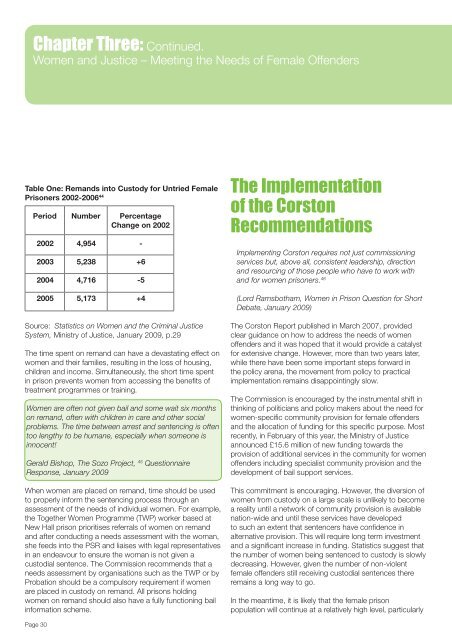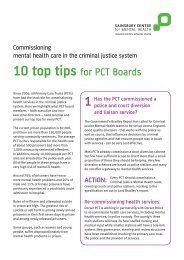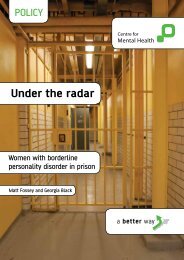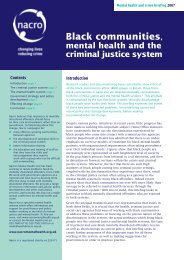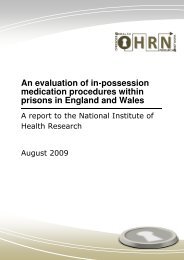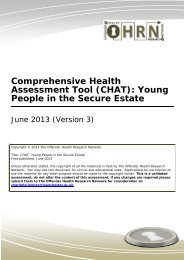Engendering Justice - from Policy to Practice - The Fawcett Society
Engendering Justice - from Policy to Practice - The Fawcett Society
Engendering Justice - from Policy to Practice - The Fawcett Society
- No tags were found...
Create successful ePaper yourself
Turn your PDF publications into a flip-book with our unique Google optimized e-Paper software.
Chapter Three: Continued.Women and <strong>Justice</strong> – Meeting the Needs of Female OffendersTable One: Remands in<strong>to</strong> Cus<strong>to</strong>dy for Untried FemalePrisoners 2002-2006 44Period Number PercentageChange on 20022002 4,954 -2003 5,238 +62004 4,716 -52005 5,173 +4Source: Statistics on Women and the Criminal <strong>Justice</strong>System, Ministry of <strong>Justice</strong>, January 2009, p.29<strong>The</strong> time spent on remand can have a devastating effect onwomen and their families, resulting in the loss of housing,children and income. Simultaneously, the short time spentin prison prevents women <strong>from</strong> accessing the benefits oftreatment programmes or training.Women are often not given bail and some wait six monthson remand, often with children in care and other socialproblems. <strong>The</strong> time between arrest and sentencing is often<strong>to</strong>o lengthy <strong>to</strong> be humane, especially when someone isinnocent!Gerald Bishop, <strong>The</strong> Sozo Project, 45 QuestionnaireResponse, January 2009When women are placed on remand, time should be used<strong>to</strong> properly inform the sentencing process through anassessment of the needs of individual women. For example,the Together Women Programme (TWP) worker based atNew Hall prison prioritises referrals of women on remandand after conducting a needs assessment with the woman,she feeds in<strong>to</strong> the PSR and liaises with legal representativesin an endeavour <strong>to</strong> ensure the woman is not given acus<strong>to</strong>dial sentence. <strong>The</strong> Commission recommends that aneeds assessment by organisations such as the TWP or byProbation should be a compulsory requirement if womenare placed in cus<strong>to</strong>dy on remand. All prisons holdingwomen on remand should also have a fully functioning bailinformation scheme.<strong>The</strong> Implementationof the Cors<strong>to</strong>nRecommendationsImplementing Cors<strong>to</strong>n requires not just commissioningservices but, above all, consistent leadership, directionand resourcing of those people who have <strong>to</strong> work withand for women prisoners. 46(Lord Ramsbotham, Women in Prison Question for ShortDebate, January 2009)<strong>The</strong> Cors<strong>to</strong>n Report published in March 2007, providedclear guidance on how <strong>to</strong> address the needs of womenoffenders and it was hoped that it would provide a catalystfor extensive change. However, more than two years later,while there have been some important steps forward inthe policy arena, the movement <strong>from</strong> policy <strong>to</strong> practicalimplementation remains disappointingly slow.<strong>The</strong> Commission is encouraged by the instrumental shift inthinking of politicians and policy makers about the need forwomen-specific community provision for female offendersand the allocation of funding for this specific purpose. Mostrecently, in February of this year, the Ministry of <strong>Justice</strong>announced £15.6 million of new funding <strong>to</strong>wards theprovision of additional services in the community for womenoffenders including specialist community provision and thedevelopment of bail support services.This commitment is encouraging. However, the diversion ofwomen <strong>from</strong> cus<strong>to</strong>dy on a large scale is unlikely <strong>to</strong> becomea reality until a network of community provision is availablenation-wide and until these services have developed<strong>to</strong> such an extent that sentencers have confidence inalternative provision. This will require long term investmentand a significant increase in funding. Statistics suggest thatthe number of women being sentenced <strong>to</strong> cus<strong>to</strong>dy is slowlydecreasing. However, given the number of non-violentfemale offenders still receiving cus<strong>to</strong>dial sentences thereremains a long way <strong>to</strong> go.In the meantime, it is likely that the female prisonpopulation will continue at a relatively high level, particularlyPage 30


